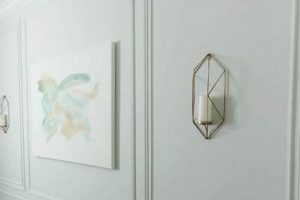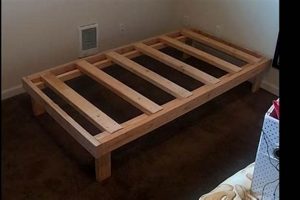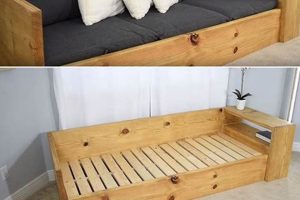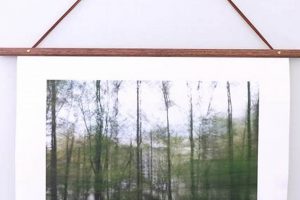The process of creating decorative borders for artwork or mirrors through individual effort is a common home improvement endeavor. This activity involves selecting materials, cutting them to specified dimensions, and affixing them to a surface to enhance its aesthetic appeal. For example, a homeowner might choose pine wood, cut it into strips, and glue those strips around a canvas print to create a custom border.
The undertaking provides several advantages, including cost savings compared to professional services, the ability to personalize designs to match individual preferences, and the satisfaction of completing a hands-on project. Historically, such decorative elements were often handcrafted, reflecting available resources and artistic traditions of the period. Today, the practice continues as a way to infuse personal style into living spaces while potentially increasing the perceived value of displayed items.
The following sections will delve into essential aspects of planning, material selection, execution techniques, and finishing touches required for successful completion of such home improvement projects.
Essential Considerations for Border Construction
The following guidelines provide a framework for achieving professional-quality results in decorative border application, ensuring longevity and aesthetic appeal of the finished product.
Tip 1: Accurate Measurement: Prior to material acquisition, precise measurements of the artwork or mirror are crucial. Employ a high-quality measuring tape and record dimensions in millimeters to minimize error. Inaccurate measurements may lead to gaps or overlaps in the finished border.
Tip 2: Material Selection: Choice of material should be guided by the desired aesthetic and environmental considerations. Wood is suitable for staining or painting; however, PVC offers moisture resistance. Consider the weight of the material, particularly when mounting on walls, to ensure structural integrity.
Tip 3: Miter Joint Precision: Accurate 45-degree miter cuts are fundamental for seamless corner joints. Invest in a miter saw or utilize a miter box and hand saw. Test cuts on scrap material are recommended before cutting the final pieces. Utilize clamps to secure pieces when gluing the joints.
Tip 4: Adhesive Application: Apply a thin, even bead of adhesive to the mitered edges. Avoid excessive adhesive, which can seep out during clamping and complicate finishing. Wood glue is suitable for wooden elements, while specialized adhesives may be required for other materials.
Tip 5: Secure Clamping: Employ corner clamps or band clamps to ensure firm, consistent pressure during the adhesive drying process. Clamping time should adhere to the adhesive manufacturer’s recommendations, typically 24 hours. Uneven clamping can result in weak or misaligned joints.
Tip 6: Surface Preparation: Prior to finishing, thoroughly sand all surfaces to remove imperfections and create a smooth base. Use progressively finer grits of sandpaper, starting with 120-grit and finishing with 220-grit. Dust removal is essential before applying any finish.
Tip 7: Finishing Techniques: Apply paint or stain in thin, even coats, allowing each coat to dry completely before applying the next. Use a high-quality brush or sprayer for a uniform finish. Consider applying a sealant or topcoat to protect the finish from scratches and moisture.
Adherence to these guidelines facilitates a structurally sound and visually appealing border, enhancing the presentation of artwork or mirrors while maintaining longevity. Precise execution is paramount.
The subsequent section addresses common challenges encountered during border assembly and proposes effective solutions for their resolution.
1. Precision measurement
In the context of creating custom borders for artwork, meticulous measurement serves as the foundational element upon which the entire project rests. Inaccurate dimensions directly translate into visible flaws, compromising both the structural integrity and the visual appeal of the finished product. This is not merely an aesthetic concern; imprecise measurements can lead to gaps, overlaps, or skewed corners, rendering the border ineffective in its intended purpose of enhancing and protecting the artwork.
The relationship between precise measurement and a successful outcome is exemplified when crafting mitered corners. These 45-degree cuts must align perfectly to form a seamless 90-degree angle. Even a slight deviation from accurate measurement accumulates across the four corners, resulting in a frame that is visibly out of square. Furthermore, consistent measurement throughout the process, from initial dimensioning to subsequent cuts, ensures uniformity and symmetry, which are critical aspects of professional-quality craftsmanship. For instance, if each piece of border material is measured and cut to a tolerance of +/- 0.5mm, the cumulative error can be minimized, resulting in a frame that accurately fits the artwork and presents a cohesive aesthetic.
Ultimately, precision measurement mitigates material waste, reduces the need for rework, and elevates the overall quality of the finished piece. By adhering to strict measurement protocols, individuals engaged in border construction can avoid common pitfalls, ensuring that the final product not only meets functional requirements but also serves as a testament to careful planning and execution. This understanding underscores the importance of investing in accurate measuring tools and developing a methodical approach to dimensioning, laying the groundwork for a successful and satisfying project.
2. Material selection
Material selection constitutes a foundational aspect of any border construction endeavor. The choice of materials directly impacts the aesthetic qualities, structural integrity, longevity, and overall cost-effectiveness of the completed project. Therefore, a comprehensive understanding of material properties and their suitability for specific applications is paramount.
- Wood Type and Grain
The selection of wood species and grain pattern exerts a significant influence on the final aesthetic. Hardwoods, such as oak or maple, offer superior durability and resistance to dents and scratches, making them suitable for high-traffic areas. Softwoods, like pine, are more easily worked but are susceptible to damage. Grain patterns can range from straight to highly figured, impacting the visual complexity of the border. Consideration should be given to matching or complementing the artwork being framed.
- Metal Composition and Finish
Metals, such as aluminum or steel, provide a contemporary aesthetic and offer exceptional strength and durability. Aluminum is lightweight and corrosion-resistant, making it suitable for humid environments. Steel offers greater strength but may require protective coatings to prevent rust. The finish, whether brushed, polished, or powder-coated, impacts the visual appearance and resistance to wear. Metal borders are often chosen for their minimalist design and industrial appeal.
- Polymer Material Properties
Polymer-based materials, including polystyrene and PVC, offer cost-effective alternatives to traditional materials. Polystyrene is lightweight and easily molded, making it suitable for intricate designs. PVC is water-resistant and ideal for areas exposed to moisture. However, polymer materials may be susceptible to scratching and fading over time. Consideration should be given to the environmental impact of plastic-based materials.
- Adhesive Compatibility
The choice of material must be compatible with the selected adhesive. Different adhesives exhibit varying degrees of bonding strength with different materials. For instance, wood glue is suitable for bonding wood, while epoxy adhesives may be required for bonding metal or polymer materials. Incompatible adhesive-material combinations can result in weak bonds, leading to structural failure of the border over time. It is essential to consult adhesive manufacturer recommendations to ensure optimal bonding performance.
The implications of material selection extend beyond mere aesthetics. Factors such as weight, dimensional stability, resistance to environmental factors, and ease of workability all play a crucial role in determining the long-term success of the border construction project. Careful consideration of these factors ensures that the chosen materials align with the intended application and contribute to a durable and visually appealing final product. The material choice is a holistic decision that combines aesthetics, functionality, and practicality.
3. Mitered corners
Mitered corners are a defining characteristic of many instances of border construction. The term refers to joints created by cutting two pieces of material at equal angles, typically 45 degrees, such that they form a 90-degree angle when joined. This technique allows for a seamless, visually appealing connection between frame components, resulting in a professional aesthetic. In border construction, the precision of mitered corners directly impacts the overall quality and appearance of the finished product. Poorly executed miter joints can lead to gaps, misalignments, and structural weaknesses. A notable example lies in the construction of wooden frames; if the miter cuts are not accurate, the corners will not align properly, resulting in a frame that is visibly out of square. The practical significance of understanding mitered corners becomes evident when considering the tools and techniques required for their creation. Specialized equipment, such as miter saws or miter boxes, and a thorough understanding of angle measurement are essential for achieving accurate and consistent results.
The creation of accurate mitered corners involves several critical steps. First, precise measurements of the material are required to ensure that each piece is cut to the correct length. Next, the material must be securely clamped to prevent movement during the cutting process. Then, the cutting tool is carefully aligned to the marked angle before making the cut. Finally, the cut surfaces are inspected for imperfections and adjusted as needed. When creating frames from hard woods like maple or oak, the sharp corners can be especially difficult to create because any imperfections are very visible. Consider applying a light coat of sanding sealer to these woods to avoid splintering while cutting miter joints. Adhesive is applied to the surfaces, and the components are carefully joined and clamped until the adhesive cures. The success of the process depends on attention to detail and adherence to proper techniques. The absence of any one of these steps will produce imperfections in the joints.
In conclusion, mitered corners are an integral element in border construction. Their accuracy is crucial to the overall quality and appearance of the finished product. While challenges may arise during their creation, a thorough understanding of the tools and techniques involved, combined with meticulous attention to detail, can enable individuals to achieve professional-quality results. Mastering the art of mitered corners is a fundamental skill for anyone engaged in border construction, contributing significantly to the creation of visually appealing and structurally sound frames. The importance of sharp, clean, closed miter joints cannot be overstated when attempting to create frames.
4. Adhesive quality
The selection of an appropriate adhesive is a critical determinant of the structural integrity and longevity of any border construction project. The adhesive serves as the primary bonding agent, uniting the various components to form a cohesive and durable framework. Suboptimal adhesive selection or application can lead to joint failure, compromising the overall aesthetic and functionality of the border.
- Bonding Strength and Material Compatibility
The adhesive must possess sufficient bonding strength to withstand the stresses exerted on the border, including tension, shear, and compression forces. Furthermore, the adhesive must exhibit compatibility with the materials being joined. For instance, wood glue is generally suitable for wooden components, while specialized adhesives may be required for bonding metal or polymer materials. Incompatibility can result in weak bonds, leading to separation or delamination over time. Consider for instance, when building a frame from pine and using water-based glue in a high-humidity environment – the wood can swell causing the joints to fail.
- Curing Time and Working Time
The curing time, or the time required for the adhesive to reach its full strength, is a critical factor in project planning. Rapid-curing adhesives allow for faster assembly but may provide less working time, the period during which the adhesive remains pliable and allows for adjustments. Slow-curing adhesives offer extended working time but require longer clamping periods. The optimal curing and working time depends on the complexity of the project and the desired pace of construction. For example, using cyanoacrylate (super glue) to assemble frame corners allows for nearly instant adhesion, eliminating the need for clamping.
- Environmental Resistance
The adhesive’s resistance to environmental factors, such as moisture, temperature fluctuations, and ultraviolet (UV) radiation, is crucial for ensuring long-term durability. Adhesives formulated for outdoor use exhibit greater resistance to these elements, preventing degradation and maintaining bond strength over time. Consider the intended environment of the completed frame; a frame intended for outdoor display requires an adhesive specifically formulated for exterior applications. Polyurethane based adhesives often offer superior moisture resistance.
- Application Method and Clean-up
The method of adhesive application can significantly impact the quality of the bond. Adhesives can be applied using brushes, rollers, or dispensing guns. Uniform application is essential to ensure consistent bond strength across the entire joint. Furthermore, the ease of clean-up is a practical consideration. Water-based adhesives are generally easier to clean up than solvent-based adhesives, reducing the risk of damage to the surrounding surfaces. Consider also the viscosity of the glue. Thin glues are best for porous material while thicker ones can bridge gaps between non-porous components.
In summary, adhesive selection is a multifaceted process that requires careful consideration of material compatibility, bonding strength, curing time, environmental resistance, and application method. The correct adhesive is paramount to the longevity and durability of the completed construction.
5. Clamping pressure
Clamping pressure, in the context of border construction, refers to the force applied to components during the adhesive curing process. It is a pivotal factor influencing the strength and aesthetic integrity of the resulting structure. Inadequate or uneven clamping can lead to weakened joints, gaps, and misalignments, significantly detracting from the final product’s quality. The appropriate application of clamping pressure ensures optimal contact between surfaces, facilitating a robust and durable bond.
- Uniform Distribution of Force
The consistent application of force across the entire joint surface is paramount. Uneven pressure can result in localized stress concentrations, leading to bond failure in those areas. For example, when assembling mitered corners, specialized corner clamps are often employed to distribute pressure evenly, preventing gaps from forming. The uniform distribution of clamping force optimizes adhesive contact and promotes a stronger, more reliable joint.
- Adhesive-Specific Requirements
Different adhesives exhibit varying requirements in terms of clamping pressure. Some adhesives require firm pressure to achieve optimal bonding, while others may be negatively affected by excessive force. It is crucial to consult the adhesive manufacturer’s recommendations to determine the appropriate pressure range. For instance, polyurethane adhesives typically require moderate clamping pressure to allow for expansion during the curing process. Adhering to these guidelines ensures that the adhesive functions as intended, maximizing bond strength.
- Clamping Techniques and Equipment
Various clamping techniques and equipment are available for border construction, each offering different levels of precision and control. Bar clamps, band clamps, and corner clamps are commonly used to apply pressure to joints. The choice of clamping method depends on the size and shape of the components being joined. For example, band clamps are well-suited for applying uniform pressure around circular or irregular shapes. Selecting the appropriate clamping technique and equipment allows for precise control over the applied pressure, contributing to a stronger and more aesthetically pleasing finished product.
- Prevention of Warping and Distortion
Proper clamping techniques can help prevent warping and distortion during the adhesive curing process. Applying consistent pressure across the entire surface minimizes the risk of uneven shrinkage or expansion, which can lead to dimensional instability. For example, when constructing large frames, multiple clamps may be used to distribute pressure evenly, preventing the frame from warping. Maintaining dimensional stability ensures that the border remains true to its intended shape, enhancing its visual appeal and structural integrity.
In conclusion, clamping pressure is an indispensable element in the creation of strong, aesthetically pleasing borders. By understanding the principles of uniform force distribution, adhesive-specific requirements, appropriate clamping techniques, and the prevention of warping, individuals can significantly enhance the quality of their projects, resulting in durable and visually appealing finished products. Ignoring these considerations will usually result in open, unstable and unattractive frames.
6. Finishing technique
The application of a finishing technique to a self-constructed border directly impacts its aesthetic appeal, protection, and longevity. The finishing process, encompassing sanding, staining, painting, and sealing, is not merely cosmetic; it serves a functional purpose by safeguarding the underlying material from environmental damage and wear. In the context of self-executed border construction, the selected method and its execution determine the final outcome. An improperly applied finish can detract from the overall appearance and compromise the integrity of the structure. For example, a poorly sanded surface may result in uneven stain absorption, creating a blotchy appearance, while an inadequate sealant can leave the material vulnerable to moisture damage, leading to warping or decay.
The selection of an appropriate finishing technique should be guided by several factors, including the material used for the border, the desired aesthetic, and the intended environment. For instance, a wooden border intended for indoor use may benefit from a stain and varnish combination, enhancing its natural grain and providing a durable protective layer. Conversely, a metal border may require a powder coating or specialized paint to prevent corrosion and maintain its appearance. The practical significance of understanding these considerations is evident in the long-term maintenance and preservation of the border. A properly finished border requires less frequent upkeep and is more resistant to damage, ultimately extending its lifespan and preserving its visual appeal.
In summary, the finishing technique is an integral component of the process of crafting borders for visual display, directly influencing the final product’s appearance, protection, and longevity. The selection and execution of the appropriate technique demand careful consideration and attention to detail. While challenges may arise, a thorough understanding of material properties, finishing options, and application methods can ensure a satisfactory and durable result. Neglecting to consider this aspect compromises the overall quality of the construction endeavor. Understanding the interaction between the raw material and the final finish will result in the highest quality completed project.
Frequently Asked Questions
The following section addresses common inquiries and misconceptions regarding the assembly of decorative borders, providing concise and informative answers to guide individuals through the process.
Question 1: What is the optimal method for achieving perfectly square corners when constructing a border?
The utilization of a drafting square or similar precision instrument is recommended. Measurements should be meticulously checked at each stage of the cutting and assembly process. Slight deviations can accumulate, resulting in a frame that is noticeably out of square. Additionally, ensuring the work surface is level will mitigate potential distortions.
Question 2: Which type of adhesive provides the most reliable bond for wooden border components?
Polyvinyl acetate (PVA) wood glue is generally suitable for most interior applications, offering a strong and durable bond. However, for exterior applications or projects exposed to moisture, a water-resistant adhesive, such as polyurethane glue, is recommended. Epoxy resins may also be considered for their superior strength and gap-filling capabilities.
Question 3: How can tear-out be minimized when cutting wood at a 45-degree angle for mitered corners?
Employing a sharp blade is essential. Using a fine-toothed saw blade and making the cut slowly minimizes the risk of splintering. Backing the material with a sacrificial piece of wood can further prevent tear-out. Additionally, scoring the cut line with a utility knife prior to sawing can help to sever the wood fibers cleanly.
Question 4: What is the recommended method for concealing nail holes or imperfections in a finished border?
Wood filler or putty, color-matched to the surrounding material, can be used to fill any blemishes. The filler should be applied sparingly and allowed to dry completely before sanding smooth. For larger imperfections, multiple applications may be necessary. Wax filler sticks are another option when the border is completed.
Question 5: Is it necessary to apply a sealant to a painted or stained border?
The application of a sealant is highly recommended. A clear topcoat protects the underlying finish from scratches, moisture, and UV damage, extending the border’s lifespan. The choice of sealant depends on the desired finish and the intended environment. Polyurethane varnishes offer excellent durability, while acrylic sealers provide good UV resistance.
Question 6: How can a border be securely attached to a wall without causing damage?
Several options exist, including adhesive strips designed for picture hanging, which offer a damage-free solution for lightweight borders. For heavier borders, screws or nails may be necessary, driven into wall studs for maximum support. When using screws or nails, pre-drilling pilot holes is recommended to prevent splitting the border material. Toggle bolts are also suitable for drywall applications where studs are not accessible.
In summary, careful planning, precise execution, and informed material selection are crucial for achieving professional-quality results. Attention to detail throughout the process ensures a durable and aesthetically pleasing border.
The subsequent section will explore advanced techniques for enhancing border designs and adding unique personalization elements.
DIY Picture Frame Molding
This exploration has elucidated the fundamental principles governing the creation of customized borders. Precise measurement, judicious material selection, accurate mitered corners, appropriate adhesive application, controlled clamping pressure, and meticulous finishing techniques are all recognized as critical determinants of project success. Each element contributes synergistically to the attainment of structurally sound and aesthetically pleasing results. Disregard for any single aspect can compromise the final outcome, underscoring the importance of a comprehensive and informed approach.
The mastery of these principles empowers individuals to enhance their living spaces through personalized design. Continued refinement of skills and exploration of innovative techniques will further elevate the craft, enriching environments and preserving cherished memories within expertly crafted borders.







